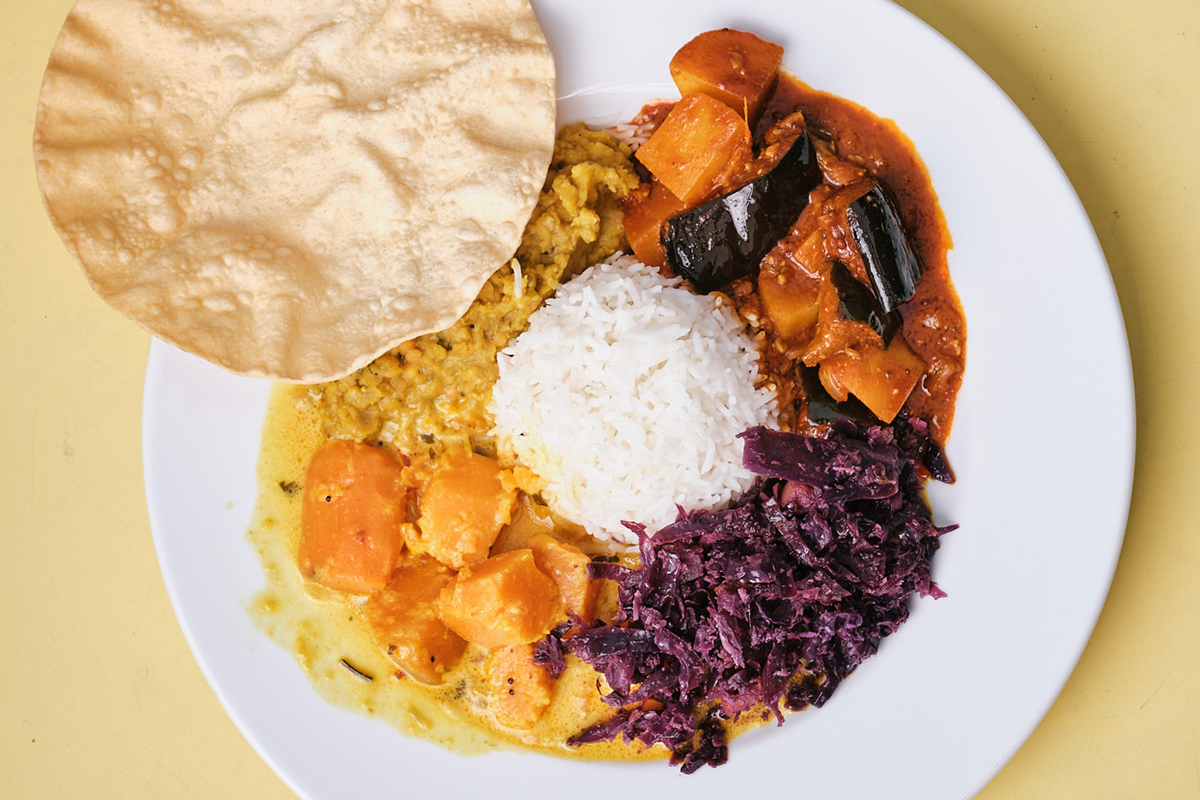Essay
Eating taboos – the cultural construction of disgust
Most societies are aware of eating taboos, but these affect different foods. The very idea of eating something that is taboo causes disgust among its members. This leads to the paradox that an involuntary physical emotion such as disgust is culturally constructed.

Food taboos exist in almost all societies, and they mostly concern meat from certain animals, rarely plants – for example, members of the Indian religion of Jainism are not allowed to eat not only meat but also root vegetables. Dog and cat meat are taboo in Switzerland, and horse meat is also taboo in Anglo-Saxon countries. If we were presented with a plate of dog ragout, we would almost certainly reject it outraged and disgusted.
Eating taboos are a mysterious phenomenon. Why does almost every society have such taboos? How is it that they are associated with a strong aversion to the avoided foods? And why do we refer to them using a Polynesian loanword?
Overcoming taboos became an enlightening duty
James Cook used the word “taboo” in the logbook of his third voyage to the Pacific in 1777 on the occasion of a visit to Tonga: “Not one of them would sit down, or eat a bit of anything. ... On expressing my surprise at this, they were all taboo, as they said: which word has a very comprehensive meaning; but, in general, signifies that a thing is forbidden.”
The pre-Christianization laws in Polynesia, which were described as taboo, were extremely strict. Ordinary people were not allowed to visit certain places of worship or to see or touch certain items; women were not allowed to eat with men and were not allowed to eat certain foods reserved for men. Women and men were not allowed to eat their clan’s totem animals. Violating one of the many taboos was said to result in sickness and death – either as an automatic sanction for breaking the taboo itself, or as a death penalty for the outrage it caused in the community.
To contemporary European observers, this system of taboos seemed cumbersome, difficult to understand and associated with arbitrary cruelty against those who violated it. In the Age of Enlightenment, the taboo ideally illustrated the alleged inability of the “savages” to introduce rationally founded laws for the benefit of all. The taboo thus became the epitome of dogmatism and backwardness in Europe, and overcoming it became an enlightening duty. Thus, the term entered everyday European languages and has since come to denote emotionally strong, socially effective prohibitions that can exist independently of formal legal prohibitions and usually have no rational justification. To this day, the term “taboo” still bears the connotation of irrationality and blind traditionalism: Taboos are often considered “wrong,” and those who “break through” them belong to the avant-garde. Those who defend a taboo, on the other hand, run the risk of being regarded as a reactionary small-minded person.
Taboos have a rational justification
In contrast, social anthropology, which has set itself the task of understanding foreign societies, has always tried to uncover a hidden rationality, even in taboos. The American cultural anthropologist Marvin Harris stood out in particular with the thesis that food taboos always have a rational justification in the ecological circumstances of their origin. Harris explains the pork taboo in Judaism and Islam by saying that at the time of its formation in the Middle East, the forests, the natural habitat of pigs, had declined and pigs had to be kept and fed on farms. As a result, they became food competitors of humans and, because they were also unhygienically confined in stables, they became a threat to human health. The ban on the consumption of pigmeat eliminated these dangers once and for all.
Another explanation for the Jewish food taboos is given by Mary Douglas. She points out that in the Old Testament the eating taboos were based on a classification system for animals. According to Leviticus, Jews were allowed to eat ruminants such as goats, sheep and cows. They were also allowed to eat many animals that were not ruminants or cloven-hoofed animals, such as chickens. Ruminants without split hooves, such as hares, were prohibited. Likewise, cloven-hoofed animals that are not ruminants, such as pigs, were prohibited. Mary Douglas argues that the Old Testament eating habits concern animals that do not fit the norm, that cloven-hoofed animals are usually also ruminants, and odd-toed ungulates are not usually ruminants. Such animals disturb the natural order to some extent and are therefore considered impure. From this she deduces that taboos concern objects and actions that contradict common classification schemes that create order and orientation in the world. They transform the classifications on which a world view is based into psychological reflexes.
I think Douglas’ interpretation of taboos is particularly interesting because it makes us understand how taboos can perpetuate themselves: They can be important components of a coherent world view handed down over generations long after their origins have been forgotten. However, in my opinion, she can only make the conservatism plausible, which holds taboos as unquestioned rules. She can’t explain the physical disgust of banned meat with her approach any more than Harris can with the explanation of eating taboos with their ecological usefulness. However, in my opinion, the collective disgust is crucial for the effectiveness of eating taboos.

Disgust can be learned together
This is illustrated by the example of a group converted to Islam, which only consistently observed the pork taboo when the members had collectively learned the feelings of disgust associated with it. In her dissertation in 2013, Sabine Zurschmitten examined how a village in the west of the island of Flores in Indonesia divided into a Catholic and an Islamic half. Originally, animism and ancestor worship had been practiced there, and the pig was the basis of every ritual meal. In the course of missions around the middle of the 20th century, part of the village professed Catholicism and another Islam. At first, these different denominations had little influence on social life in the village. They continued to intermarry and held joint feasts, at which nominal Muslims also ate pork. From the 1980s, separate meat dishes for Muslim and Catholic believers were introduced at festivals, but people continued to eat and celebrate together. Twenty years later, the festive congregation separated for food according to religious groups. This separation took place against the background of heightened religious differences throughout Indonesia and with them an ever-increasing public display of Muslim food taboos on the one hand and a celebration of the public consumption of pork and dog meat by Christians on the other. Dog meat had traditionally been avoided throughout Flores, but as a result of solidarity with Christian groups in other parts of Indonesia, some of which traditionally consume dog meat, it was also given the status of “Christian” food in Flores. Young Catholic men in particular demonstratively overcame their disgust for dog meat. Muslims increasingly reacted with physical expressions of disgust in the presence of eating Catholics, who in turn were outraged by this, so that to avoid conflicts, they renounced eating together. Interestingly, older Muslims remember having eaten pork in community rituals right into the 1980s. Today, however, it disgusts them, and they claim to no longer tolerate even the sight of pork-eating Catholic relatives. By visibly expressing their feelings of disgust, they identify themselves affectively with their own group and differentiate themselves from each other through physical aversion.
Being creative with eating taboos
This confirms the thesis of the cultural psychologist Paul Rozin, according to which the expression of disgust, which had originally been used, as suggested by Charles Darwin, to warn others against intolerable food, took over the function of expressing aversion to behavior that deviates from the norm. Food taboos combine both: They socialize the disgust of “incompatible” food and the reluctance to break a strict social norm. A side effect of such socialized reluctance is to strengthen the group identity vis-à-vis those who do not abide by their own taboos.
The study of eating taboos thus focuses attention on affective attachment and repulsion forces in the constitution of society. In our multicultural society in particular, it is important not to simply condemn them as backward and irrational, but to respect them in the interest of peaceful coexistence and, if necessary, to deal with them creatively.
About the Person
Heinzpeter Znoj is a full professor at the Institute of Social Anthropology and conducts research in Indonesia on traditional agriculture and resistance to land grabbing by plantation companies. His interests include the global food system and the anthropology of food.
New magazine uniFOKUS

Subscribe free of charge now!
This article first appeared in uniFOKUS, the new University of Bern print magazine. Four times a year, uniFOKUS shows what academia and science are capable of. Thematically, each issue focuses on one specialist area from different points of view and thus aims to bring together as much expertise and as many research results from scientists and other academics at the University of Bern as possible.
The online magazine of the University of Bern

Subscribe to the uniAKTUELL newsletter
The University of Bern conducts cutting-edge research on topics that concern us as a society and shape our future. In uniAKTUELL we show selected examples and introduce you to the people behind them – gripping, multimedia and free of charge.